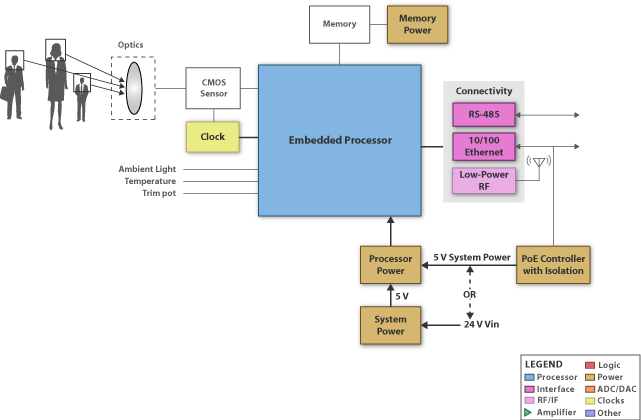
Design Considerations
TI Intelligent Occupancy Sensing (IOS), which is a new vision-based method of detecting and counting the number of people in given area, is ideally suited for applications that require a high degree of control. This technology is also considered most suitable when the space is intermittently occupied, and where lights and HVAC (Heating, Venting and Air Conditioning) systems are typically left on when the space is unoccupied. Appropriate applications include offices, classrooms, copy rooms, restrooms, storage areas, conference rooms, warehouses, break rooms, corridors, etc. In contrast, scheduling typically is most suitable for larger areas, such as entire buildings and multiple spaces tied together on the same schedule. Scheduling is also often appropriate for public spaces where occupancy is typically predictable and based on a schedule – or where the lights must remain on even when the space is unoccupied, such as lobbies. To provide proper automatic lighting shutoff for a building, a combination of scheduling devices and occupancy sensors may be desirable. Occupancy sensors can provide local control for private spaces, while scheduling panels can provide global control for the building depending on its operating schedule.
In terms of cost savings, intelligent HVAC control offers a higher potential than lighting because the cost of heating, venting and conditioning any given space is much more. In the US, the HVAC airflow is regulated by OSHA (Occupational Safety and health Administration) and is tied to the number of potential people in the room. Consequently, if no sensors are present, the room must be ventilated during normal working hours according to the maximum number of people that could be in the room (maximum seating capacity), thereby wasting a lot of energy. An IOS system can exactly count the number of people and precisely regulate HVAC airflows depending on actual occupancy.
Another potential use for IOS is conference room usage optimization for a complete building automation system. IOS can provide feedback on meetings that are scheduled, but never attended. The information provided could be used to put unused rooms back on the open schedule or notify the user that they need to cancel recurring meetings if never attended.
With the move towards a Green environment, intelligent occupancy sensors offer a means to accomplish this task as significant energy savings from using such devices can be achieved; 40% to 46% in classrooms, 13% to 50% in private offices, 30% to 90% in restrooms, 22% to 65% in conference rooms, 30% to 80% in corridors, and 45% to 80% in storage areas. Besides minimizing energy consumption, occupancy sensors can also be used for security (by indicating that an area is occupied.)
Some technologies today incorporate multiple innovative technologies such as PIR (passive infrared) and ultrasound into an occupancy sensor. TI's vision-based method, however, takes advantage of DaVinci™ Digital Media Processors to do all the video analytics required for the job. In general, an Intelligent Occupancy Sensing system can be broken down into a few major blocks; the digital media processor (including the video analytics engine), image sensor, industrial interfaces, low-power wireless connectivity, power management devices from a 12V – 24 V supply, and battery management in case of power failure.
Download Full Block Diagram Below
Click here for Solutions Guide
Advertisement

Learn more about Texas Instruments





